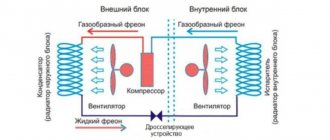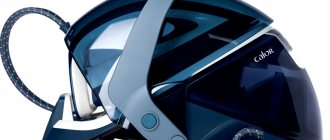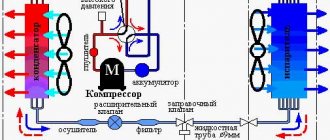Split system device
A multi-block design includes at least two modules. Internal equipment is located directly in the room, the outdoor unit is usually installed on the facade of the building. Special tubes are used to connect the two modules. Cooling gas flows through them - freon or freon.
The main element is the external block.
It contains the following elements:
- device for condensation of air masses;
- compressor;
- ventilation system;
- throttle.
The compressor compresses the cooling gas and moves it. A condensation device is used to convert a gaseous substance into a liquid. Using the throttle design, the pressure of the working medium is reduced before it enters the indoor module. The indoor unit includes a ventilation device and an evaporator. A fan is used for forced air circulation. With the help of an evaporator, the liquid is converted into a gaseous state.
Split systems can be used to cool air masses in a room with several rooms. This design includes an external module and the required number of internal units.
Advantages of a separate design
When answering the question of how an air conditioner differs from a split system, you should consider the advantages of a separate design. Cooling devices with several separate modules have a number of advantages compared to conventional air conditioners:
- they are distinguished by increased power. They can be used to maintain a given temperature in fairly large rooms;
- Such modules operate almost silently. This becomes possible due to the design features of the device. The noisiest block is located on the street. A compressor is installed in it. Internal modules operate quietly, without making loud sounds;
- indoor units differ in installation location, spatial orientation, size and shape. This allows you to make the optimal selection of the necessary equipment for a specific room.
Further - more interesting
And so you ask:
WHAT IS THE DIFFERENCE OF AN AIR CONDITIONER FROM A SPLIT SYSTEM?
We answer:
The air conditioner has fundamentally the same design as the split system, and indeed any climate system. In the case of a simple air conditioner, it should be installed (embedded) in the window with its back facing outwards. This is where the heat exchanger, inherent in any climate system, is located. If you just put it in the room, it won't do any good. The heated air in the heat exchanger immediately mixes with the cooled air.
In a split system, the heat exchanger is made in the form of a separate block and is located outside the building (room). This gives greater flexibility in the placement of climate control equipment. The performance of climate control equipment, among other things, also depends on the size of the heat exchanger. It's like a car's cooling system.
Split systems consist of two blocks: internal and external. The noisiest and most voluminous part of such air conditioners is the external one. It is located outdoors. The internal part can be installed in any convenient place.
Air conditioners of this type are highly functional and virtually silent. However, it should be noted that some split systems require suspended ceilings. Depending on the placement of the indoor unit, split systems are divided into wall-mounted, floor-mounted, ceiling-mounted and cassette-mounted. The most common are wall-mounted split systems, where the indoor unit is mounted on the wall under the ceiling.
Duct air conditioners stand apart from the split systems. Their outer part is attached to the walls of buildings, cornices or balconies. The internal part is located in openings behind suspended ceilings. Such air conditioners easily fit into any interior, because... they are practically invisible - only the air distribution grilles remain visible.
They easily cope with the distribution of cooled or warm air in large rooms, and thanks to the built-in special systems, air conditioners help make the air not only clean, but also humidified. If there are many rooms in the room and you want to use air conditioners in all of them, then experts recommend paying attention to multi-split systems, which allow you to connect from two to eight external units. Currently, split systems are represented on the market by LG, Daikin, Panasonic, and Sanyo.
Window air conditioners, as the name suggests, are installed in window openings. Due to their fairly simple design, such air conditioners are easy to install. In addition, they are less demanding than split systems. However, experts note that in recent years there has been a decline in purchasing of such models. The main reasons for this are, first of all, the bulky appearance of air conditioners and their noise.
READ MORE: The computer does not turn on - we are looking for the reason ourselves. Instructions
Also, during installation, the natural lighting of the room deteriorates significantly, because... they take up part of the window. Currently, such air conditioners are mainly used in trade pavilions and government institutions. Despite the consumer downturn, manufacturers continue to improve window air conditioners. So many models with remote control from Panasonic, Toshiba, Sharp, LG Electronics appeared on sale.
Mobile air conditioners do not require their owners to have a specific location. Such air conditioners are easy to transport from place to place. You just need to take the corrugated hose outside (through a window, window or balcony), turn on the air conditioner and that’s it – the indoor climate begins to improve.
However, this type of air conditioner has a relatively high noise level, a small operating area, an insufficiently accurate level of temperature maintenance, and a limited location from the window (no more than 2 meters).
Let's understand the concept of “conditioning”.
Air conditioning is the process of bringing indoor microclimate parameters to optimal values. “Optimality” depends on the purpose of the room: in residential premises the air should be comfortable for the human body, in production - to ensure the uninterrupted functioning of equipment.
Air conditioners control air parameters such as temperature and relative humidity. Both parameters are of great importance for humans and the environment.
Cassette split systems
This type of air conditioner is usually used in rooms with suspended ceilings. They are best suited for rooms with a large area. For example, very often cassette split systems are installed in shops, offices, restaurants and cafes. Air enters them through a special hole located in the center of the block. It is thrown out in four directions at once. Therefore, cassette split systems are most often installed in the center of the room. The advantages of this type of equipment, in addition to efficient air cooling, include an attractive modern design and small size.
Similarities between split systems and air conditioning
First of all, the similarities between split systems and air conditioners include the fact that they use the same operating principle. The air in the room is forced through a system of tubes through which a refrigerant circulates, removing heat from it when cooling the room or releasing it when heating. Thus, the elements included in all types of climate control equipment do not differ in their purpose, but may differ in type and size.
When all types of air conditioning operate, heat is generated that must be removed outside the room. The operation of the devices is accompanied by noise.
Floor split systems
Sometimes owners of apartments and houses are also interested in the question of what is better - a floor-mounted air conditioner or a split system. Both types of equipment have almost the same design. Floor models also consist of two blocks. The internal one is located on the floor and has a very thoughtful design. Thanks to its unusual design, cold air is distributed throughout the room very evenly. Flows in such split systems come out both from above and from below. The external and internal blocks of models of this type communicate with each other using flexible hoses, freon tubes and electronic devices. The advantages of split systems of this type, among other things, include ease of installation. Models have significant power and are usually installed in rooms with a large area or where disruption of architectural features is undesirable (in museums, exhibition halls, etc.).
Which is better - split system or air conditioning?
Whether a mobile air conditioner or a split system is better depends on many nuances. Before purchasing equipment, you need to evaluate:
- room size - air conditioners do not cope well with rooms larger than 25 m2;
- difficulty of installation - if for some reason you cannot touch the walls and ceilings in the apartment, it is better to opt for mobile equipment;
- equipment requirements - a budget monoblock is suitable for cooling and heating a small room, but to clean the air from allergens and dust, deodorize and ionize, you need to buy a more expensive system.
It is also necessary to take into account which specific room requires climate control equipment. In the living room or office, you can install equipment with an average noise level. For the bedroom, you should choose only the quietest systems from two modules, the important difference of which is a special night mode.
Design and principle of operation of a split system
The split system consists of indoor and outdoor units, an electronic panel, and a remote control. Outdoor unit components:
- fan, condenser, compressor;
- control board (available in inverter models);
- four-way valve (in models with heating);
- filters;
- protective cover.
The indoor unit consists of the following components:
- front panel - through it the system takes in air;
- coarse filter;
- a system of several fine filters;
- fan;
- blinds (vertical and horizontal) - help control air flow;
- indicator panel;
- control board;
- fitting connections.
The split system does not generate cold on its own, but transfers heat from the room to the street (or vice versa, if heating is on).
To cool the room, you need to remove the warm air generated during operation. Heat is energy, and it cannot evaporate into nothing. The carrier, as in a refrigerator, is a special substance - refrigerant. Air conditioners typically use freon.
Split system device
After evaporation, the refrigerant picks up heat. To understand this process, you can pour alcohol on your hands. You will feel colder as the solution begins to draw energy from the surface of the skin. The refrigerant, if it condenses, on the contrary, gives off heat.
When the split system is set to cooling mode, the substance evaporates in the indoor unit and is transferred to the outdoor unit, where it settles. For heating - everything is exactly the same, but in reverse order.
Features of the split system
A split system is designed to solve the same problem as an air conditioner - to cool the air in the room. The equipment differs structurally, since it consists of two or more parts: for installation inside the room and outside the room . In this case, the blocks are connected by thermally insulated copper tubes.
On a note! When installing a split system, depending on the installation location, the connecting elements can be decorated with a cable duct, hidden behind a suspended ceiling, or placed inside the wall.
How the equipment works and works
The split system uses the compressor cooling principle. The noisiest components - the compressor and fan - are routed to the external unit of the system, which is attached to the wall outside. The remaining elements - condenser, evaporator and filters - are located in the indoor unit, intended for installation indoors. Usually the indoor unit is made in a stylish design so that it can be harmoniously integrated into the interior.
Important! A split system requires professional installation skills, so it is better to contact a service center to install it.
Depending on the level of equipment, the functionality of different models may differ. The main features of split systems are as follows:
- setting the desired temperature via the remote control;
- remote switching between modes: cooling, heating, ventilation, humidification;
- purification of air masses coming from the street;
- automatic control of specified parameters.
Types of split system
Modular air conditioning equipment can be mounted on the wall, ceiling and floor. Based on these conditions, split systems are divided into types:
- wall-mounted - the most popular type in the household equipment sector;
- column (aka floor) - with fastening to the floor;
- cassette, duct and ceiling - mounted inside the ceiling.
In addition to division according to the principle of installation, this climate control equipment is classified according to the method of operation and power parameters, that is, how effectively rooms of different sizes will be cooled . Thus, simple split systems operate in a cycle: the engine turns on - runs to the desired temperature - turns off.
Models equipped with an inverter can operate continuously, automatically reducing or increasing engine power. In addition, inverter split systems do not allow temperature fluctuations, so a person does not have any unpleasant sensations when the device is operating.
Multi-split systems have become widespread in mini-hotels, multi-room apartments, houses and offices. The multi prefix in the name means that it is possible to connect several indoor units located in different rooms to one powerful external air conditioning unit.
Where the power of a multi-split system is not enough, multi-zone (aka VRV) systems are used. These are centralized industrial-grade air conditioning systems. They are suitable for use in hotels, hospitals and office centers.
Which is better – air conditioning or split system?
Most modern houses and apartments have plastic windows and completely sealed doors. Therefore, to maintain a good indoor microclimate, it is necessary to use various types of additional equipment. First of all, this is, of course, ventilation.
But you can’t do without air conditioners in such apartments and houses either. Otherwise the rooms will be too hot. Today, stores sell climate control equipment of various designs. If desired, you can purchase either a monoblock version of this type of equipment or a two-block version.
In this regard, many owners of houses and apartments have a question about what is better - an air conditioner or a split system?
Types of monoblock equipment
The main advantage of conventional air conditioners is, first of all, their low cost. Equipment of this type consists of one block. Its design may be different. Currently, there are the following types of monoblock air conditioners on the market:
- window;
- mobile;
- roof
Performance for efficient cooling
Monoblock products are designed for air conditioning rooms with an area of 15-35 square meters. m. And models related to split systems are more powerful, which gives them the ability to cope with the same work in rooms reaching 50-80 sq. m. m. Although most of them are also designed to work in small areas.
The monoblock air conditioner fits perfectly into the interior and does not take up much space. But its most sought-after characteristic is mobility.
This leads to the conclusion: monoblock air conditioners should be purchased only for cooling air in small living rooms, kitchens, offices, and commercial premises. Whereas split systems can operate effectively in a wider range of areas. This factor is important to consider when choosing.
Noisiness is the main drawback
The superior performance of split systems occurs because the noisiest part of their design, called the compressor, is located outdoors. Therefore, manufacturers can provide models belonging to this type with any necessary power, without the risk of reducing the comfort of people’s lives.
As for monoblock products, the compressor that makes noise, due to its design features, is located inside the housing, and therefore, in a residential or office space. As a result, designers are limited in their ability to increase their productivity, which leads to an increase in noise and sound pressure.
Such discomfort will interfere with living a peaceful life, reading a book, working, and will certainly harm your health. This is a pressing problem, and it is reflected in the legislative acts of all post-Soviet countries.
As a result, monoblock units are inferior to their two-block counterparts not only in power, which is not critical, but also in noise. The last point is fundamental for many potential buyers who make a choice in favor of models of one or another type of air conditioner.
Window air conditioners are also monoblock, but today they are not in demand, so they are rare
But you shouldn’t make a premature decision, since the noise level of monoblock air conditioners is simply slightly higher than that of split systems, but it is within the framework of common sense and various regulations.
Therefore, it all depends on the person’s personal perception and it is recommended to simply make a comparison. Although the clear advantage in this matter belongs to two-block units.
Functionality: no clear leader
Split systems are often equipped with various additional equipment, for example, ionizers, effective filters, various control sensors, etc. And they have additional functions that make the work better and less energy-consuming.
Yet, most often, opponents of monoblock air conditioners complained about such inconveniences as the need to drain condensate manually. In some cases this operation had to be performed every 3 hours.
In addition, there was insufficient accuracy in monitoring indoor climate conditions, which led to mediocre quality of implementation of the established program.
But today it is no longer uncommon to find models of monoblock air conditioners that are devoid of the listed disadvantages. They can independently remove moisture to the heat exchanger, so you no longer need to devote time to the air conditioner every few hours.
In a monoblock air conditioner, only the air duct is in contact with the outside air, which adds reliability to the product
And also in recent years, the quality of room temperature control has significantly improved; as a result, the errors of models from leading manufacturers have become insignificant. For example, Electrolux monoblock air conditioners have long had deviations within 1 °C, which is quite decent.
If a potential buyer plans to use the equipment throughout the year, including for heating, then you should pay attention to the availability of such an opportunity. Since heating using split systems is recommended only in the spring-autumn period, or more precisely, up to -5 °C.
Therefore, in most cases, an air conditioner will not replace the main types of heating (centralized or autonomous system).
You can ignore the stated rule that in the worst case, everything will end in failure when starting in severe frost. If the outcome is favorable, the unit will be able to survive only 2-3 winters, which is not enough, given the cost of modern air conditioners. The reason for the short service life will be increased wear of the loaded parts of the compressor.
Additional equipment will help to avoid such problems, but even this will not prevent a decrease in power by 3 times in twenty-degree frost. This will make the system ineffective.
Monoblock air conditioners do not have this feature - they are always indoors. And for heating, built-in ceramic heaters are used that do not burn oxygen.
This is a frozen external unit of the split system; this will never happen with a mobile air conditioner.
As a conclusion, we can point out that the buyer should take into account the following feature: the clear advantage of split systems appears only in the segment of the most technologically advanced, and, therefore, expensive products. Therefore, if you have the money to buy a unit with a self-cleaning function, climate control and other options, then it is better to buy a split system.
If you don’t want to spend money on all the latest features, then the functionality will be of a similar level. Therefore, it will be necessary to make a choice based on other advantages and disadvantages.
Window air conditioners
Many, answering the question: “Split system or air conditioner - which is better?”, pay attention first of all to the compact models of the first group. Equipment of this type is installed, as the name suggests, in a window.
In addition to low cost, the advantage of such models is their small size. The disadvantages include, first of all, the fact that they occupy window space, as a result of which the intensity of lighting in the room is significantly reduced.
In addition, such models are quite difficult to install, and it is recommended to dismantle them for the winter.
Mobile models
“Split system or air conditioning - which is better?” is the question most often asked by owners of small apartments and country houses. For such premises it is worth choosing an inexpensive mobile model. This type of air conditioner has recently become very popular. The main advantage of mobile single-block air conditioners is, of course, the ability to move them easily.
These models differ from window models in that they are installed on the floor and have not one, but two fans. All units of this type are equipped with wheels. Such air conditioners usually weigh no more than 8 kg. Therefore, you can, for example, take them with you to the dacha in the summer. The main disadvantage of this type of equipment is that it is not very convenient to use.
Condensation in mobile models is collected in a special container, and the owners of an apartment or house have to pour water out of it every few hours. In addition, such air conditioners have low power and therefore do not cool the air very well. So the answer to the question of what is better – a mobile air conditioner or a split system – is simple.
For a large room, it is better to choose equipment of the second type.
Rooftop air conditioners
The question of which is better, an air conditioner or a split system, is often asked by owners of industrial workshops. If the enterprise’s capacity is large, experts recommend choosing monoblock rooftop models. These air conditioners are highly efficient.
Their advantages include:
- low noise characteristics;
- possibility of remote and automatic control;
- no need to lay freon routes.
The disadvantage of these models is their very large size and difficulty in installation.
Monoblock air conditioner models are an outdated option
Two types of air conditioners have a monoblock design: window and mobile. Window air conditioners are practically not used today due to the big problems associated with their operation, but mobile models of air conditioners are still present on the market and are also available for sale in our store.
However, all mobile air conditioners have big drawbacks: low power (they can only serve one room up to 25 sq.m.
), bulky dimensions, unattractive appearance and a corrugated pipe that needs to be routed out into an open window for ventilation to ensure hot air is removed from the room.
And, most importantly, all the noise from the operation of the compressor (and it operates loudly - 45-50 dB) remains indoors, and it is simply impossible to rest or sleep with the mobile air conditioner on!
Split system: the most modern air conditioner!
Another thing is a wall-mounted split system: the entire noisy and bulky part is taken outside and placed in the outdoor unit, and the wall-mounted indoor unit receives minimal dimensions and improved consumer characteristics (low noise level, the possibility of comfortable air distribution, etc.)
Depending on the location of the indoor unit, there are wall-mounted, floor-ceiling, duct, column and cassette types of split systems. The outer unit for all of them is placed on the outer wall of the building, but the inner unit can be placed on the wall or hidden under the ceiling, installed inside the ventilation system, or built into the Armstrong suspended ceiling.
The most popular type of split systems is wall-mounted. Wall-mounted split systems are used for apartments, houses, offices and retail spaces. One wall split system serves one room. You can choose an inverter or non-inverter model for your premises.
An inverter air conditioner has a minimal noise level of the indoor unit, you will not get cold under it (provided that the air flow is not directed directly at you), most often such models have a function for adjusting the position of the blinds, they will save you up to 20-25% of electricity when operation of the air conditioner, and most importantly, they can be used in cooling mode down to -15 degrees outside.
Non-inverter models of wall-mounted air conditioners cost a little less, but they make noticeably more noise - 26 dB, create a strong flow of cold air, which can cause you to catch a cold, and, in addition, they can only be used up to 0-5 degrees outside the window.
There is an option to install a multi-split system when one external unit and several internal ones are installed; such air conditioning systems are most often installed in offices and cottages.
The advantage of such systems is that the facade of the house is not overloaded with many external blocks, but only one external block is installed. The downside is that if your external unit breaks, all internal units of this multi-split system will not be able to function.
Also, you will not be able to use the air conditioner for cooling and heating in different rooms; you will only have one option: cooling or heating.
Apartments with a large area require several rooms; in such rooms you can use ducted air conditioning systems; they are also suitable for private houses, offices and cottages.
These air conditioner models are installed inside the home's ventilation system, thus combining these two systems into a single one.
Flexible air ducts of the ventilation system are used to ensure the distribution of cooled air inside the premises, and to draw air from inside these premises.
Which model to choose for a large room?
If you are the owner of a large office or store, the following will suit you:
Floor-ceiling (console) air conditioning systems.
These types of air conditioners are installed under the ceiling or on the bottom of the wall (as close as possible to the floor) and in terms of their characteristics (working life, reliability) they no longer belong to household, but to semi-industrial models.
Their advantage lies in the uniform distribution of the treated air, which is possible due to the direction of a powerful jet of cooled air along the wall and ceiling.
Cassette air conditioners in Krasnoyarsk are used in most shops and retail premises. These models are built into a suspended ceiling, so they do not take up useful space and do not attract unnecessary attention. Their advantage is the distribution of cooled air in 4 directions at once, therefore ensuring uniform cooling even in large premises.
Column split systems. These are models that are ideal for local air cooling in large offices, hotel lobbies, and sports arenas with high ceilings.
They work quite quietly, without creating extraneous noise that will disturb and distract.
And the presence of vertical automatic blinds in tandem with a wide air flow ensures rapid cooling/heating of the air in the room and its excellent uniform distribution.
The main differences between an air conditioner and a split system
In an effort to maintain optimal room temperature, many people purchase climate control equipment.
These products are now sold by both specialized retail outlets and household appliance stores. When choosing between varieties and models, buyers are often faced with a lack of understanding of the difference between air conditioners and split systems. In fact, split systems are the same air conditioners, but why then did the device get a second name? This article will help you understand the differences between air conditioners and split systems.
All climate control equipment works on a similar principle. The main differences lie in the design and additions that improve the functionality of the devices and allow them to be used in certain conditions. Therefore, the key difference between an air conditioner and a split system is the number of housings.
Simple household air conditioners are considered monoblock, since all components are placed in one housing. The elements of the split system are divided into two blocks. The outdoor unit is a compressor-condensing unit, and the indoor unit is an evaporator. The external unit of the split system includes a condenser, compressor and fan, and is mounted on the roof, balcony or wall of the building. The indoor unit is installed directly in the room.
Monoblock air conditioners are divided into two types: window and mobile. The former require minimal installation work for installation in a window opening, the latter do not require installation at all. A split system, unlike a window or mobile type air conditioner, is installed permanently, which requires additional time and financial costs.
According to the design of the internal unit, split systems are divided into:
- traditional, with wall-mounted unit indoors;
- floor-mounted, where the inner part is installed on the wall near the floor;
- cassette-type split systems, where the unit is suspended from the ceiling;
- column units that are placed on the floor.
In addition to the listed types, you can find a hybrid version between monoblock and multiblock cooling systems on sale. This is a mobile split system that uses division into two movable parts. Instead of traditional copper tubes for the freon line, such units use flexible hoses enclosed together with the cable in a protective sheath.
The main advantage of monoblock air conditioners is mobility. If a conventional split system is not so easy to move from place to place, then the air conditioner can be taken with you to another apartment or cottage. In addition, this reduces the cost of the equipment itself and its maintenance.
The structural difference between a split system and an air conditioner gives it the advantage of silent operation and higher efficiency. In addition, split systems have a wide range of functions and a “winter-summer” mode.
Conclusions:
- Split systems are one of the types of air conditioners.
- Simple household air conditioners are considered monoblock; the elements of the split system are divided into two blocks: external and internal.
- Monoblock air conditioners require minimal installation work or do not require installation at all. Split systems are installed permanently, so installation work is larger in volume, time and cost.
- Air conditioners can be moved to another room or house, split systems are fixed in space.
- Split systems are quieter and more efficient than air conditioners.
- Air conditioners are cheaper than split systems.
- Split systems have a larger range of functions and modes.
READ MORE: Drop-down list in Excel: how to create and link data – WindowsTips.Ru. News and tips
Comparison of other parameters: what is the difference between a split system and an air conditioner
It is worth noting that according to the principle of operation, the monoblock is no different from the split system. And literally. Like refrigerators, they work on the basis of freezing as freon evaporates and heating as it liquefies during the compression process. But there is also a difference:
- One of the main differences is the noise level. Thus, the split system is almost inaudible, since its noisy part is located on the street. But the air conditioner is quite noisy; after all, the 45-65 decibels it produces are really comparable to city noise. And this is the reason why air conditioners, in which the fan is located inside the unit, have almost disappeared from the market.
- Also, the difference between a split system and an air conditioner lies in the cost, or more precisely, in the installation costs. You definitely won’t be able to install a split system yourself, especially if we are talking about an apartment above the first floor. That is, installation costs will also be added to the funds spent on the purchase.
How does a split system differ from a conventional air conditioner?
Device
As mentioned above, the split system consists of two blocks. Mobile and window models have only one housing. A second, very important feature follows from this.
Installation
Splits should only be installed by professionals. Installation of such devices is complicated and often requires the use of a lift truck. Monoblocks are simpler in this regard. They can be installed by the buyer himself after reading the instructions.
Convenience and comfort of use
Due to the fact that the external unit of the split systems hangs outside, there is no strong rattling in the room.
The mobile air conditioner is in the room and makes a loud hum. To remove hot air, you need to insert a pipe into the window, which violates the aesthetics of the apartment. And large sizes also do not decorate the interior.
Monoblocks can be purchased for rented housing, for apartments in buildings where nothing can be hung on the façade. In other situations, it is better not to suffer and purchase a household split.
Both types of air conditioners are easy to operate. You can set the desired operating parameters and set a timer.
Service
All types of air conditioners require refilling with freon. If the systems can be partially refueled, then mobile devices must be fully recharged, having first pumped out all the refrigerant.
Filters and drainage need to be washed both there and there.
Splits need to be serviced at least once a year. Approximately every three years the external unit needs to be cleaned from fluff, dust and insects.
Price
Monoblocks are cheaper. Split systems are more expensive, and you need to pay additional fees for installation and maintenance.
These are the fundamental differences between an air conditioner and a split system in an apartment. Industrial splits have an even more complex design and installation. But all the same, they are all united by the fact that they consist of two blocks. If there are more blocks, we are talking about multi-split systems.
Household split air conditioner
Today, the split design is the most efficient and low-noise climate system. The noisiest unit - the outdoor one - contains a compressor that compresses the refrigerant to a pressure of 20 atmospheres, and a main fan that immediately removes heat from the compressed freon.
If the fan does not blow the heat out of the heated freon in time, it will overheat in a few minutes or half an hour to an hour to a temperature above the critical one, and the coil will break through at its weakest point (a soldered joint or at one of the bends). For this purpose, an external fan is made with large impeller blades, rotates at decent speeds and produces noise of up to 30-40 decibels. The compressor, compressing freon, adds its own noise - and increases its overall level to 60 dB.
The indoor unit of a split air conditioner contains a freon evaporator, which is strongly cooled when the refrigerant liquefied by the compressor of the outdoor unit passes into gaseous form. This cold is picked up by the air flow created by the propeller of the internal fan and blown into the room, due to which the temperature in the room is 10 degrees or more lower than outside. At +35 in the summer heat outside the window, you will get +21 in the room in half an hour. A thermometer inserted into the slightly open curtains (blinds) of the indoor unit will show +5... +12, depending on the load level of the entire split system.
Liquefied (in the smaller diameter of the tubes) and gaseous (in the larger) freon circulates through the pipelines, or “route”. These tubes connect the coils (circuits) of the external and internal units of the split air conditioner.
A type of split system used in private homes and all-season country houses is a floor-ceiling design. The outdoor unit is no different from a wall-mounted split system, and the indoor unit is located either in the ceiling near the wall, or a few tens of centimeters from the floor.
The temperature readings of the blocks are read every second by temperature sensors located on the coils, compressor and externally on the indoor unit of the air conditioner. They are transmitted to the electronic control module, which controls the operation of all other components and blocks of the device.
The split solution is characterized by the highest energy efficiency and efficiency. That is why it will not lose its relevance for many years.
Comparison of the most important characteristics
Although many general features were listed above, design nuances have an impact. Therefore, both varieties have a number of characteristics unique to their species, both positive and negative.
Performance for efficient cooling
Monoblock products are designed for air conditioning rooms with an area of 15-35 square meters. m. And models related to split systems are more powerful, which gives them the ability to cope with the same work in rooms reaching 50-80 sq. m. m. Although most of them are also designed to work in small areas.
The monoblock air conditioner fits perfectly into the interior and does not take up much space. But its most sought-after characteristic is mobility.
This leads to the conclusion: monoblock air conditioners should be purchased only for cooling air in small living rooms, kitchens, offices, and commercial premises. Whereas split systems can operate effectively in a wider range of areas. This factor is important to consider when choosing.
Noisiness is the main drawback
The superior performance of split systems occurs because the noisiest part of their design, called the compressor, is located outdoors. Therefore, manufacturers can provide models belonging to this type with any necessary power, without the risk of reducing the comfort of people’s lives.
As for monoblock products, the compressor that makes noise, due to its design features, is located inside the housing, and therefore, in a residential or office space. As a result, designers are limited in their ability to increase their productivity, which leads to an increase in noise and sound pressure.
Such discomfort will interfere with living a peaceful life, reading a book, working, and will certainly harm your health. This is a pressing problem, and it is reflected in the legislative acts of all post-Soviet countries.
As a result, monoblock units are inferior to their two-block counterparts not only in power, which is not critical, but also in noise. The last point is fundamental for many potential buyers who make a choice in favor of models of one or another type of air conditioner.
Window air conditioners are also monoblock, but today they are not in demand, so they are rare
But you shouldn’t make a premature decision, since the noise level of monoblock air conditioners is simply slightly higher than that of split systems, but it is within the framework of common sense and various regulations.
Therefore, it all depends on the person’s personal perception and it is recommended to simply make a comparison. Although the clear advantage in this matter belongs to two-block units.
Functionality: no clear leader
Split systems are often equipped with various additional equipment, for example, ionizers, effective filters, various control sensors, etc. And they have additional functions that make the work better and less energy-consuming.
Yet, most often, opponents of monoblock air conditioners complained about such inconveniences as the need to drain condensate manually. In some cases this operation had to be performed every 3 hours.
In addition, there was insufficient accuracy in monitoring indoor climate conditions, which led to mediocre quality of implementation of the established program.
But today it is no longer uncommon to find models of monoblock air conditioners that are devoid of the listed disadvantages. They can independently remove moisture to the heat exchanger, so you no longer need to devote time to the air conditioner every few hours.
In a monoblock air conditioner, only the air duct is in contact with the outside air, which adds reliability to the product
And also in recent years, the quality of room temperature control has significantly improved; as a result, the errors of models from leading manufacturers have become insignificant. For example, Electrolux monoblock air conditioners have long had deviations within 1 °C, which is quite decent.
If a potential buyer plans to use the equipment throughout the year, including for heating, then you should pay attention to the availability of such an opportunity. Since heating using split systems is recommended only in the spring-autumn period, or more precisely, up to -5 °C.
Therefore, in most cases, an air conditioner will not replace the main types of heating (centralized or autonomous system).
You can ignore the stated rule that in the worst case, everything will end in failure when starting in severe frost. If the outcome is favorable, the unit will be able to survive only 2-3 winters, which is not enough, given the cost of modern air conditioners. The reason for the short service life will be increased wear of the loaded parts of the compressor.
Additional equipment will help to avoid such problems, but even this will not prevent a decrease in power by 3 times in twenty-degree frost. This will make the system ineffective.
Monoblock air conditioners do not have this feature - they are always indoors. And for heating, built-in ceramic heaters are used that do not burn oxygen.
This is a frozen external unit of the split system; this will never happen with a mobile air conditioner.
As a conclusion, we can point out that the buyer should take into account the following feature: the clear advantage of split systems appears only in the segment of the most technologically advanced, and, therefore, expensive products. Therefore, if you have the money to buy a unit with a self-cleaning function, climate control and other options, then it is better to buy a split system.
If you don’t want to spend money on all the latest features, then the functionality will be of a similar level. Therefore, it will be necessary to make a choice based on other advantages and disadvantages.
Reliability and mobility of devices
It would seem that structurally similar and equally functional products should have similar reliability. This is true, but the external units of absolutely all split systems operate in a more aggressive environment, which significantly reduces the durability of these products. Still, this is a natural process and there is nothing to complain about.
The external block of any model is rigidly attached to the external wall, and the internal block to the wall or floor. It turns out that every product belonging to this type is purely stationary.
This is a significant difference from most monoblock air conditioners, which designers install on rollers. As a result, the owner can always move it to the desired corner or even another room, if there is a possibility of exhausting hot air there. This will help not only to obtain high-quality cooling, but also to save money.
For example, split systems can make the climate comfortable in only one room. If you need to cool the air in adjacent parts of the building, you need to buy additional air conditioners. But monoblock products can be transported from the kitchen to the bedroom and other rooms. True, this is not entirely convenient - it is only suitable as an economy option.
This is how heat is removed from the room when a monoblock air conditioner is operating. These temporary inconveniences should be taken into account when allocating space
Monoblock air conditioners also have a significant limitation in the form of a flexible hose leading into a slightly open window or a hole in the wall. It is impossible to do without this element, since it is designed to remove hot air outside the room.
As a result, monoblock products, according to many users, are considered only conditionally mobile. However, this is not an obstacle to transporting them to the dacha, when transporting them to another rented apartment.
There are also mobile split systems on sale, but their insignificant sales volumes, as well as the reluctance of most manufacturers to develop such equipment, indicate its unpopularity.
About the cost of installation work
Today, installing a split system is not a cheap pleasure. Even when there are no particular difficulties for performing this operation, you will have to part with an impressive sum, equal to 20-30% of the cost of the purchased product.
You can save money by entrusting the work to non-professionals, but this is fraught, since durability depends on the correct installation, and significantly.
Installation of the external unit of a split system is a complicated and therefore expensive procedure. But you shouldn’t save on it - it can lead to big problems
Owners of monoblock air conditioners do not have installation problems. Since it will work anywhere it is installed. But with one limitation - it is necessary to ensure that the flexible pipe through which hot air is transported is removed outside the home or office.
To do this, they make a hole in the wall or window, which is also an additional expense, although in this case everything is simpler and cheaper. These works can be replaced with a cover made of dense polyester fabrics, such as polyester.
It is quickly and easily placed between the window frame and any of its sash installed for ventilation. Then a hose is attached to the hole to remove air.
This is what the room looks like where the indoor unit of any split system is installed. Therefore, it is advisable to plan the installation at the same time as the repair
Often, owners of monoblock air conditioners get out of the situation by leading the pipe directly into a slightly open window. Such a solution can only be considered as temporary, because it will significantly cool the air, but at a significantly higher cost of electricity, which is unprofitable.
For comparison: this is often how a monoblock mobile air conditioner is “mounted”, although this is not the most economical way
In this category, despite all the limitations and difficulties, monoblock air conditioners clearly have an advantage. This means that owners of such products significantly save money at the stage of purchasing and installing the selected unit.
The importance of design when choosing a device
A monoblock air conditioner is most often a structure with a height of within 70 cm, the width of most models does not exceed 40 cm.
The design of the internal units of a split system is very diverse, as they come in different thicknesses and lengths. If necessary, you can even hide such a device. Manufacturers offer a wide range of body colors.
The design of the internal units of split systems is much more diverse; this design element can even be hidden
In practice, buyers do not have any special requirements - most often they purchase classic white products that easily fit into any home, office, or store environment. Still, a person with a special taste is better off choosing a split system due to the greater variety of design solutions.
People living or working on the lower floors of buildings should take into account that external units located within the reach of vandals often suffer from their actions.
To prevent damage to the equipment, it should be placed as high as possible if the neighbors do not mind this. It is possible to provide for protective structures. Which means additional costs.
Industrial split systems
A duct air conditioner uses supply and exhaust ventilation ducts that have no outlet outside the building. One or more indoor units can be located on different floors or in different clusters of a single-story building. The outdoor unit (one or more) extends beyond the building. The advantage of this design is the simultaneous cooling of all rooms on one floor or even the entire building. The disadvantage is the complexity of the design, the enormous complexity of its installation, maintenance or replacement of some or all parts and components with new ones.
A column air conditioner is an indoor unit approximately the size of a household refrigerator. It is floor-standing. An external split block is taken outside the building and installed close to the ground or suspended almost under the very roof of the building. The advantage of this design is its enormous cooling capacity compared to most household systems.
Column air conditioning is a common occurrence in the trading floors of hypermarkets with an area of up to several thousand square meters. If you turn it on at full power, then within a radius of several meters around you it will create the cold that feels like autumn-winter. The disadvantages of the design are large dimensions and energy consumption.
Multi-split system is a replacement for the two previous varieties. One outdoor unit operates on several indoor units, separated into different rooms. The advantage is that the original appearance of the building is not spoiled by a scattering of separate split blocks near almost every window. The disadvantage is the length of the system, limited by the length of the “route” of 30 m between the outdoor and one of the indoor units. If it is exceeded, such an air conditioner is no longer effective, no matter what the thermal insulation of the “tracer” pipes is.
Monoblocks
The window block contains all the parts and components of the system. Advantages - the ability to fence a window or above a door with bars, the “completeness” of the device (structural and functional blocks are not separated, “2 in 1”). Disadvantages: much lower energy efficiency compared to a split system, high noise level. For this reason, window units have turned from a top offering to a niche one.
Mobile air conditioners are portable units that require only one thing: a hole in the wall for an air duct that discharges superheated air to the street. The advantages are the same as those of a window air conditioner.
Disadvantages of mobile air conditioners:
- in each of the rooms where the device is used, a hole is drilled for the air duct, which is closed with a plug when not in use;
- the need for a container into which the water condensate will be drained;
- cooling performance is even worse than that of window air conditioners;
- The device is not designed for rooms with an area of more than 20 m2.
Some more interesting facts
Choosing an air conditioner is not an easy task. This is not an item that you can give up on, say “it doesn’t fit, we’ll buy another one,” and with a light heart put the unsuccessful purchase into the far corner.
Both a floor-standing air conditioner and a split system are quite expensive devices designed to serve their owner for quite a long time. That is why it is so important to make the right choice and buy an air conditioner that is best suited for your purposes.
So, which is better: a split system or a floor-standing air conditioner? Let's try to look at the advantages and disadvantages of each of these air cooling devices.
Advantages of floor-standing air conditioners:
- Portability. After all, even the second name of a floor-standing air conditioner sounds like “mobile candy bar.” This device can be installed in almost any convenient place indoors (placement near heating and heating devices is not recommended).
- Simplicity and ease of installation. If you decide to buy a floor standing air conditioner, then you won't have to worry about calling a professional to install it. Installation of such an air conditioner is quite easy and simple: install the monoblock indoors and lead its air duct into the ventilation or outside (through a window or hole in the wall).
- Many models have a timer and remote control, as well as air ionizers and fine filters.
Disadvantages of floor-standing air conditioners:
- Limited power (usually up to 4 kW). However, such devices cope with their functions quite effectively, especially in rooms with a small area (apartments, country houses, offices).
- The noise level of floor-standing air conditioners (compared to stationary devices) is quite high.
- The need to periodically clean the pan from accumulating condensate. If you do not want to carry out this procedure every day, then it is best to buy a floor-standing air conditioner with a capacious condensate collector.
Advantages of split systems:
- Low noise level (less than 30 dB). The noisiest part of the device is mounted on the outside of the building.
- High power (up to 7 kW and more). Thus, split systems can effectively cool or warm the air in rooms with a large area (up to 100 m2).
- Large range of indoor units. You can buy a split system that will best fit into the interior of the room.
- Many types of split systems. For retail facilities, it would be more advisable to buy a cassette split system that sprays cooled air in 4 directions. Huge column air conditioners are usually installed in rooms with a large area (conference rooms, restaurants, etc.). Duct split systems are capable of supplying cooled air to several adjacent rooms at once, and multi-split systems can create a favorable microclimate in rooms located at a considerable distance from each other. You can also opt for floor-ceiling split systems with a power of up to 15 kW or standard wall-mounted air conditioners.
- Many models have ionization and air purification functions.
READ MORE: Top 10 best fitness bracelets - 2021 rating
Disadvantages of split systems:
- Requires professional installation. Installation and maintenance of such devices should only be carried out by specialists.
- Many split systems (not counting cassette systems) cannot create a flow of fresh air into the room.
- The cost of split systems (especially installations with high power) is quite high.
Criteria for choosing climate control equipment
Only with a clear understanding of the needs, the choice of climate control equipment will be optimal in terms of money and functionality.
Therefore, when choosing an air conditioner, you should consider it:
- performance/power;
- requirements for operating conditions and functionality;
- noise level;
- the cost of a specific model;
- installation price.
Also, do not forget about the built-in ionizers and additional air filters. Often they are not needed, but they give a considerable markup.
You should immediately decide what is required in the end. The range of air conditioners is huge, so you can find an option to suit any needs, you just need to clearly formulate them for yourself
If you only need to cool the air and the room is small, then it is best to purchase a simple cooler. Unlike an air conditioner, it is not as noisy and costs less. But in other cases you will have to choose between a two-block split system and a window or floor monoblock.
Factor 1 – noise and power
The most important criterion for choosing a model of climate control equipment is the level of noise emitted by this equipment during operation. If the selected equipment makes a lot of noise, it will cause discomfort.
And here it doesn’t matter how well the air is cooled. The rustling sound of a fan is one thing, but the hum of a running compressor is quite another.
If the noise in the room needs to be reduced to a minimum, then only a split system should be used. By this criterion, a conventional monoblock air conditioner loses to it in this matter quite strongly.
Noise is the main disadvantage of monoblock air conditioners. All operating units in this case are located in the room and during operation create a background that puts pressure on the ears
A working split system produces sound at a level of 45–55 dB. The noise of a mobile air conditioner is 50–60 dB. And its window analogue will produce even more, plus the rattling of glass in the window will be added.
The difference in decibels is small at first glance. However, the constant hum can drive you crazy. The less noise the air conditioning equipment makes, the better. This is especially true when there are small children in the house or the air conditioner is installed in the study. There is a clear advantage here for the split system.
In terms of performance, the monoblock also loses to the two-block system. The more powerful the equipment, the larger and heavier it is. In a split, a more efficient compressor in the outdoor unit is not a problem. You simply can't see it outside the window. How big and noisy it is is not so important for most buyers.
The monoblock has serious limitations in this regard. Inserting a powerful compressor into it means filling the room with noise and making the device enormous in size. This option becomes unsuitable for installation in a window and loses its mobility when installed on the floor.
The floor-standing monoblock looks great in the interior, and when not needed, it can be easily stored in a closet, utility room or further away in a corner. However, it will not cope with cooling a large room.
Compact mobile air conditioners are designed to cool air in rooms with an area of 10–35 sq.m., and household split systems are designed for rooms up to 80 sq.m.
Even if you turn it on at full power, in extreme heat outside the window it is not always able to fulfill its purpose. Plus, under such operating modes, the device will quickly overheat and may burn out. Here it is better to rely on a split system.
To simplify the calculation of the required equipment power (Q), you need to add:
- Q1 – represents the sum of heat inflows emanating from the windows, walls and ceiling of the room;
- Q2 – heat generated by people who are in the room;
- Q3 – the amount of thermal energy released by household appliances.
Each person in the room generates about 100–150 W of heat. Q2 is easy to calculate. To calculate Q1, you need to multiply 30–45 W by the cubic capacity of the room. Plus, the rated power of computers, televisions, lighting devices and all other household appliances is added to this, multiplied by 0.3.
To the resulting total amount, 10–15% is added in reserve. And you can go choose an air conditioner. If there is a model of a mobile air conditioner for the calculated data, then you can purchase it.
But often the required power is quite high. Then to cover it - remove excess heat from a particular room, you have to take a split system.
Factor 2 – cost of equipment and installation
In terms of equipment price, household air conditioners do not differ much from split systems of similar power, but the higher the performance, the more noticeable this difference is. The first option in a mobile version with 1.5–2.5 kW costs approximately 10–15% cheaper than the second with similar kilowatts.
The cost of installing a household split system is estimated at 30 to 50% of the price of the purchased equipment. These costs are often unknowingly missed by owners of apartments and private houses when choosing air conditioning equipment for their homes.
The difference is insignificant, but we must also add the cost of installation work. To operate a floor-standing monoblock, simply place it in the room and plug it into the network.
A split system must first be installed indoors and outdoors, and then the outdoor and indoor parts must be connected together. As a result, the total costs of setting up the system are far from the same.
If the installation of a split is offered to be done cheaply - less than a third of the cost of the device, then you should be extremely careful. There is no saving in this matter. The connection between the external and internal blocks is made by copper tubes through which freon circulates.
If the quality of copper soldering is poor, the refrigerant will begin to leak out of the system, and literally after a couple of months you will have to call the installers again to top it up and solder the leak.
Also, the cost of installation is strongly influenced by the need to use special equipment for work at heights. If the split system is installed in an apartment on the upper floors of a tall building, then you may need to call a lift or invite an industrial climber. And this is always additional expenses.
Factor 3 – convenience and reliability
In terms of service life, much depends on the manufacturer of the air conditioner and the quality of its installation. The outdoor unit of the split system has to endure the effects of various precipitation, wind and sudden changes in air temperature throughout the year.
And the monoblock is located indoors and is free from all this. It seems that the second option should obviously serve longer than the first.
However, the split system is initially designed taking into account climatic factors. Only there is a very important point in it - this is the quality of soldering of copper pipes with freon.
If the blocks are connected by a professional, then such a system often outperforms a monoblock air conditioner in terms of reliability and durability. But with unqualified installation, everything is exactly the opposite.
The main disadvantage of a mobile monoblock air conditioner is the need to somehow expose a corrugated pipe with heated air blown from the heat exchanger into the window or door; such installation does not always look aesthetically pleasing
The monoblock is sold pre-assembled at the factory. It will definitely serve its warranty period. It takes some effort to disable it. You just need to correctly calculate the power of the equipment and not kick it accidentally.
In terms of available functions, split systems and monoblock air conditioners with comparable power indicators and prices are practically the same. Their cost is more affected by the manufacturer’s brand, as well as the presence of additional ionizers, filters and air dehumidifiers. There is no clear leader here. It is necessary to compare specific models.
What is an air conditioner?
An air conditioner is a compact climatic device that maintains the optimal air temperature in the room according to a set value. It consists of one block containing a compressor, condenser, evaporator, fan and other important elements responsible for the functionality of the device.
There are two types of household air conditioners:
- Window models placed in the window opening.
- Mobile devices with a special corrugated hose that leads outside. Such devices are usually installed closer to the window. For ease of movement, the air conditioner is equipped with wheels. The kit includes a special tray where condensate is collected.
Mobile air conditioner
The mobile air conditioner is installed on the floor, near a window through which a hose is routed to drain condensate. It is very convenient for cooling air in small rooms, but it makes a lot of noise during operation. It can be reinstalled if necessary. The price range ranges from 10-25 thousand rubles. Power from 2 to 3.8 kW. Modern models of non-inverter air conditioners of this type have appeared on the household appliances market. Unlike most devices, their noise level is very low, and energy is used sparingly.
There are additional functions of dehumidification, ventilation and heating. The included remote control creates additional ease of use.
Window air conditioner
A window air conditioner is installed in the window opening. It can be used in extensions, private houses and in the country. The price range is between 9.5-39 thousand rubles. Power from 1.5 to 3.5 kW. Expensive products are equipped with additional functions: drying, ventilation and heating.
Operating principle of the air conditioner
Air conditioners operate from the electrical network on the principle of heat absorption by liquids during evaporation and its release during condensation. The device is equipped with a refrigerant circulating in a closed circle.
As a result
Based on the review of the concepts “air conditioner” and “split system”, we can safely say that this is practically one concept, if you do not take into account monoblocks and multi-split. The classic split is a type of air conditioner and performs the function of ensuring optimal climatic conditions in the apartment. What is better is an individual choice for everyone.
This simple truth allows you to cast aside doubts about how the devices differ and pay attention to modern devices that differ in their functionality. Fortunately, today equipment is presented to customers not only as devices for regulating the temperature in the house, but also as stylish, convenient and autonomous units that are a pleasure to use.
Sources
- https://mymeizu-online.ru/klimat/otlichie-kondicionera-ot-split-sistemy.html
- https://oboiman.ru/ingeneer/kondicioner-i-split-sistema-v-cem-raznica-osnovnye-otlicia-i-na-cem-lucse-ostanovit-vybor.html
- https://technosovet.ru/klimaticheskaya-tehnika/kondiczioner/raznicza-mezhdu-kondiczionerom-i-split-sistemoj
- https://qteck.ru/otlichie-split-sistemy-ot-kondicionera-i-chto-luchshe-vybrat.html
- https://sovet-ingenera.com/vent/cond/kondicioner-ili-split-sistema.html
- https://remkasam.ru/otlichie-split-sistemy-ot-kondicionera-i-chto-lychshe-vybrat.html
- https://www.officemag.ru/info/guide/index.php?ID=13443283
- https://stroy-podskazka.ru/split-sistemy/otlichiya-kondicionera/
- https://sovet-ingenera.com/vent/cond/kondicioner-i-split-sistema-v-chem-raznica.html
- https://ventilation-conditioning.ru/tipy-ventilyacii/kondicioner-i-split-sistema.html
[collapse]











